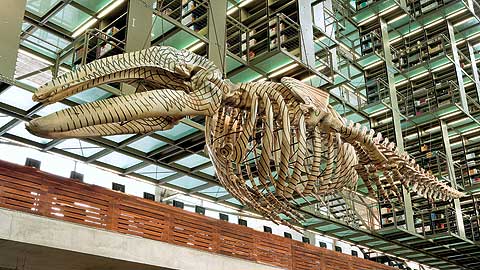This semester the Methods Visual Knowledge affinity group attended the South Eastern College Arts Conference (SECAC) held this year in downtown Pittsburgh. At the conference our group members attended a variety of panels and presentations that directly related to our class discussions of Visual Knowledge.
A two-session panel was organized by Professors Rex Koontz and Luis Castaneda and titled “Theories of the Object in the Art of the Americas.” Both sessions included papers that offered in-depth analyses of objects from North, South and Central America. Professor Koontz chaired both sessions and made a point in his introduction to explain that the word ‘object’ as opposed to ‘artwork’ was a deliberate choice on his and Professor Castaneda’s part. Although they did not reference the work of George Kubler or David Summers, the specific use of the term object clearly suggests a broader consideration of what art historians can and should study regardless of whether or not the object is seen as art. This line of reasoning relates to our group’s discussion of how to write about objects as both visual forms and didactic tools. The first panel’s objects were: a graphite drawing-covered whale skeleton, greenstone sewing tools, 20th century Peruvian retablos, and an 18th century portrait of George Washington. As the objects were so varied, the approaches taken in this panel were similarly diverse. Jodi Kovach, in making sense of Gabriel Orozco’s Mobile Matrix, the aforementioned whale skeleton, built her argument of the object on the question of whether or not it could be considered a new symbol of Mexican nationalism, as perhaps intended by the Mexican government that commissioned it. She referenced Benjamin Bochloh’s interpretation of Orozco’s art as being subconsciously asserting Mexican identity while framing the making of Mobile Matrix in the social and political climate of Mexico in the mid 2000s. The title of her talk, “Remotely Mexican: The Critical Reception of Gabriel Orozco’s Whale Skeleton, at Home and Abroad,” played on how Orozco’s national identity as Mexican is somewhat fraught, heralded globally as a Mexican artist yet having lived and reached prominence outside of Mexico. The ‘object’ in this case was intended as art, specifically for installation in a prominent library in Mexico. Kovach considered the materiality of the object, but by referencing critical reception and Mexican politics, her argument was much richer.
Continuing within the trend of visual knowledge were two groups of speakers speaking within digital humanities methods. The first of these speakers were Duke University’s Timothy Shea, and our own University of Pittsburgh professor Alison Langmead and graduate student Clarisse Fava-Piz. Between their respective talks, (“Digitizing Athens: Reconstructing the Urban Topography of Athens with GIS,” “Sustaining MedArt: Assessing the Persistence and Longevity of a Pioneering Digital Humanities Project,” and “Mapping Spanish Sculptors in Paris 1880-1914, or How Digital Technologies Enhance Traditional Visualizations in Art History,”) the digital and methodological tools they used manifest into themes within the Visual Knowledge constellation. These projects exemplify not only compelling arguments of community, identity, and mobility, but also present and future trends of digital tools used in the humanities. Clarisse’s project that traces Salon catalogs of Spanish sculptors in early 20th century Paris combines data visualization that poses its own argument on community-building and its mobility through time. Shea’s mapping of ancient Athens helps us better understand tomb-makers’ stylistic trends within ancient Athens through ArcGIS mapping. Langmead’s media archaeological approach helps us better understand Gothic architecture through website and media analysis and the pedagogical tools used in the 1990s and early 2000s. Through these visualizations, we can better see and understand vast argumentation through visual methods that do not rely on text alone.
Continuing along this vein was Saturday morning’s panel entitled “Art History and Science,” which did not rely so much on science as it did on computer engineering and “hacking” tools of the digital variety. In fact, two of the three projects could have been presented with Langmead, Shae, and Fava-Piz’s. University of North Carolina Wilmington’s art historian Vibeke Olsen and environmental scientist James Rotenburg presented an art historical and computer engineering project entitled “When Art and Science Meet: Revealing Patterns of Artistic Transmission using Geo-Spatial Technology.” Their research program traces limestone capital styles in the southern-France Romanesque using ArcGIS (and scans limestone with neutron-activation analysis), with the intention of working with the tourism industry to better help present their findings within their current information architecture. This is to say that their findings, that could not be otherwise exemplified in simple text and traditional maps, are to help visitors better understand the stylistic history of Romanesque cathedrals, so that the visitors can maximize their knowledge of that period through the use of contemporary, up-to-date, technologically sophisticated mapping.
This last digital humanities project encapsulates the themes of visual knowledge in a robust yet light-hearted visualization. Again we see Duke University’ Wired Lab bring to the forefront an outstanding project, Alexandra Dodson and Mariano Tepper’s “Projecting Polychromy: The Art and Science of Displaying Medieval Sculpture.” Here, archeological models are brought to life through re-visualizing pre-Modern reliefs of the apostles: while passing through an otherwise looked-over exhibit, patrons (and especially young adults and children) can play with a screen interactive that projects possible color schemes onto the relief. In bridging and blurring the art museum with science-museum-like interactives, patrons can engage with otherwise ignored or passed-over objects. In learning through playing, knowledge is not simply visual, though that is a compelling and interesting outcome; but they also learn the history of color use in pre-Modern objects. And because this team is expanding their scope to employ these technological and digital methods to other exhibits of the Nasher Museum at Duke, they’re hopeful that other exhibits can come alive with new iterations and knew knowledge of the past.
Lily Brewer
Marina Tyquiengco
Krystle Stricklin
Yijing Wang

